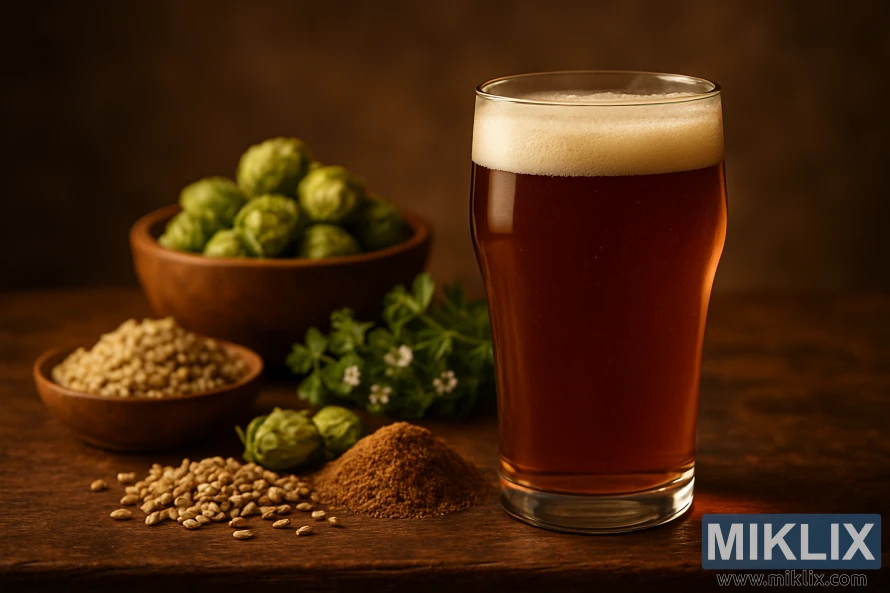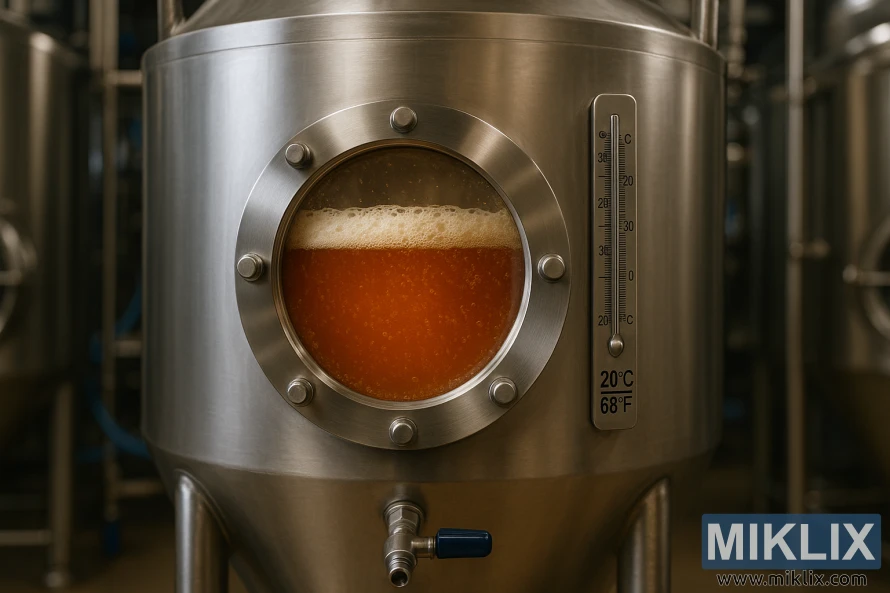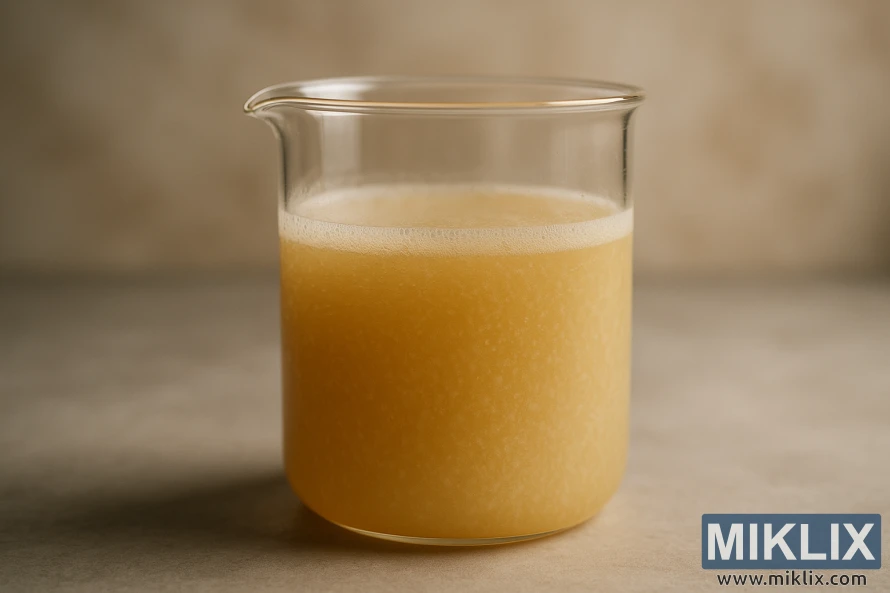Fermenting Beer with Lallemand LalBrew London Yeast
Published: October 8, 2025 at 5:27:21 PM UTC
This LalBrew London review aims to provide brewers with a detailed look at using Lallemand LalBrew London Yeast for authentic English ales and ciders. LalBrew London is a Saccharomyces cerevisiae top-fermenting dry yeast from Lallemand's Yeast Culture Collection. It's part of the company's Heritage Strains. Known for its dependable, vigorous fermentation and traditional British character, it's a favorite English ale yeast.

The technical sheets highlight its moderate ester production, medium attenuation, low flocculation, and a fermentation temperature range suited for classic British styles. This article offers practical guidance for homebrew yeast handling in the United States.
Readers will discover what to expect when fermenting beer with LalBrew London. Topics include fermentation performance, pitching and handling tips, rehydration versus dry pitching advice, strategies for managing maltotriose limitation, storage and shelf-life notes, and troubleshooting common issues.
Key Takeaways
- Lallemand LalBrew London Yeast excels at producing flavorful, traditional English-style ales with steady, vigorous fermentation.
- Expect moderate esters, medium attenuation, and low flocculation—ideal for cask and bottled ales.
- Proper pitching rate and attention to oxygen and nutrients improve attenuation and vitality.
- Rehydration can boost early activity, but careful dry pitching also works for many homebrewers.
- Store packets cool and dry; monitor shelf life to maintain reliable fermentation performance.
What is Lallemand LalBrew London Yeast
LalBrew London is a true English-style ale strain, part of the Lallemand Yeast Culture Collection. It's a top-fermenting dry brewing yeast, chosen for its classic UK beer profiles. Brewers rely on it for its reliable performance and authentic English character.
The organism behind LalBrew London is Saccharomyces cerevisiae, known for clean ester production and predictable attenuation. It's POF negative, meaning it won't produce clove-like phenolics that can disrupt delicate malt and hop balance.
Typical analysis reveals percent solids between 93 and 97 percent, with viability at or above 5 x 10^9 CFU per gram of dry yeast. The microbiological profile shows wild yeast and bacteria each below 1 per 10^6 cells. The strain tests diastaticus negative.
- Heritage strain from Lallemand Brewing’s collection
- Top-fermenting Saccharomyces cerevisiae suitable for ales
- Dry brewing yeast format for easy storage and pitching
Choose LalBrew London for a dependable English-style ale strain. It ferments clean, finishes well, and is easy to handle for both homebrewers and professional breweries.
Flavor and aroma profile of LalBrew London
LalBrew London's flavor leans towards a neutral to slightly fruity spectrum. This allows brewers to focus on the nuances of malt and hop. The yeast character is subdued, ensuring that the traditional English malts and British hops take center stage.
The aroma is characterized by a subtle malty note with a hint of ester influence. Descriptions often include red apple, green apple, and mild banana, along with tropical fruit hints. This subtlety is why many brewers appreciate its balanced estery profile.
In styles like Extra Special Bitter, Pale Ale, Bitter, and Mild, LalBrew London enhances the malt and hop profiles. The fruity esters add depth but remain in the background, enriching the beer without overpowering it.
For cider makers, LalBrew London's mild ester production is a boon. It preserves the fresh fruit character while introducing a gentle aromatic lift.
- Neutral yeast character: supports malt-forward recipes.
- Estery but restrained: adds complexity without dominance.
- Malty aroma: underpins traditional English styles.
- Fruity esters: subtle notes that enhance, not overpower.

Best beer styles to brew with LalBrew London
LalBrew London excels in brewing classic English-style ales. It's a top choice for Bitter, Mild, and traditional Pale Ale recipes. These styles emphasize malt and hop nuances.
For Extra Special Bitter, LalBrew London's yeast character is key. It creates a rounded malt profile and gentle fruit esters. This makes ESB yeast perfect for a balanced, sessionable beer with depth.
In hoppy English pale ales, LalBrew London's performance is evident. Its moderate ester profile keeps hop aroma bright. It also lets crystal malts and English pale malts shine through.
Choose LalBrew London for beers with a fuller body or slight residual sweetness. Its maltotriose handling supports traditional British mouthfeel. This is without overpowering yeast flavors.
The strain also works well in light ciders, adding a clean, slightly fruity fermentation. Fermenting in the classic British temperature range ensures authenticity for English ale yeast styles.
- Bitter: clean fermentation and subtle esters
- ESB: rounded malt presence with ESB yeast traits
- Pale Ale: balanced hop lift using pale ale yeast
- Mild: soft body and gentle sweetness
- Light cider: clean, fruity notes when desired
Opt for LalBrew London in recipes that highlight malt complexity and hop nuance. Its neutral, dependable profile aligns with many English ale yeast styles. It helps brewers create faithful, flavorful pours.
Fermentation performance and kinetics
Under standard wort conditions at 20°C (68°F), LalBrew London fermentation performance is notable for a short lag and a rapid active phase. Brewers report vigorous fermentation that often reaches terminal gravity in about three days when pitch rate, oxygenation, and nutrients are appropriate.
Fermentation kinetics vary with handling and environment. Typical attenuation sits in the medium range, commonly 65–72%, which shapes body and residual sweetness. Lag phase, total fermentation time, and final attenuation respond to pitching rate, yeast health, fermentation temperature, and wort nutrition.
Low flocculation is part of the strain's character, so yeast may remain in suspension and sometimes trap yeast during conditioning. That behavior affects apparent attenuation and can extend perceived fermentation time unless rousing or longer maturation is used.
- Lag phase: brief under correct oxygen and pitch conditions.
- Active fermentation: vigorous fermentation with strong CO2 and krausen development.
- Alcohol tolerance: capable of finishing beers up to about 12% ABV when warmed and well-fed.
Monitoring specific gravity and judging yeast activity give the best read on real fermentation kinetics. Adjust pitch rates, provide nutrients, and keep temperature steady to align LalBrew London fermentation performance with your planned schedule and flavor goals.

Optimal fermentation temperatures and range
Lallemand suggests a LalBrew London temperature range of 18–22°C (65–72°F) for classic British ale character. This range allows for moderate esters, keeping malt and hop notes balanced and clear. It's crucial for achieving the desired flavor profile in English ales.
At 20°C (68°F), LalBrew London exhibits brisk activity and reaches medium attenuation on pale and amber grists. This temperature often results in a clean profile with light fruity esters. Brewers aiming for traditional English ales find this ideal.
Temperature fluctuations impact ester formation and yeast behavior. To ensure consistency, maintain the English ale fermentation temperature within the recommended range. Gradual adjustments are safer than sudden changes.
- Avoid sudden shocks when adding rehydrated yeast to wort. A drop greater than 10°C can reduce viability and stress cells.
- Hold wort near pitching temp and use gradual attemperation if needed to match yeast slurry or rehydrated packs.
- Monitor and correct temperature drift during peak activity to prevent off-flavors.
Fermenting above 22°C will introduce more estery, fruity notes. Fermenting below 18°C slows yeast activity, potentially leaving more residual sweetness. Select a temperature within the LalBrew London range to align with your beer style and flavor objectives.
Pitching rates and yeast handling recommendations
For most ales brewed with LalBrew London, aim for a LalBrew London pitching rate of 50–100g/hL. This range gives about 2.5–5 million cells per mL. It supports a healthy start to fermentation and a predictable lag time.
Measure dry yeast by weight rather than volume to stay inside the 50–100g/hL window. Use a reliable scale and record the grams per hectoliter for consistency across batches.
Stressful worts need more attention. High gravity, heavy adjuncts, or low pH can prolong lag phase and reduce attenuation. Increase the pitch above 50–100g/hL in those cases and add yeast nutrients to support vitality.
Dry yeast handling affects performance. Add yeast to lukewarm, oxygenated wort if re-pitching, and avoid thermal shock. For first pitches, rehydration is optional but careful dry yeast handling improves early activity and reduces lag.
Use a pitch rate calculator when precision matters. Lallemand’s pitch rate calculator gives strain-specific cell targets. It helps adjust for gravity, temperature, and repitching schedules.
- Weigh packets to hit the target grams per hL.
- Adjust upward for high gravity or stressed fermentations.
- Ensure proper aeration when repitching dry yeast into wort.
Pitch rate, yeast handling, wort nutrition, and fermentation temperature interact to shape flavor and attenuation. Keep records of pitch weight, aeration, and temperature to refine future batches using LalBrew London.

Rehydration versus dry pitching methods
Brewers face a decision between rehydration LalBrew London and dry pitching, influenced by beer strength and process risk. Lallemand recommends rehydration for high-stress conditions, such as high-gravity wort or heavy adjunct use.
To follow a simple rehydration protocol, sprinkle yeast over ten times its weight in sterile water at 30–35°C (86–95°F). Stir gently, then rest for 15 minutes. Stir again and rest for five minutes. Acclimate the slurry by adding small wort aliquots without dropping the temperature more than 10°C. For extra protection in challenging ferments, use Go-Ferm Protect Evolution during rehydration.
Dry pitching offers speed and simplicity. Many brewers achieve consistent results with LalBrew London by pitching dry into cooled wort. Lallemand states that dry pitching and rehydration show no significant performance difference for routine ales.
Opt for rehydration in sour worts, very high gravity, or when oxygen and nutrient exposure are limited. Avoid rehydrating in wort, distilled, or RO water. Temperature shock and long natural cooling during attemperation can reduce viability. Inoculate rehydrated yeast into cooled wort without delay.
- When to rehydrate: harsh fermentations, high adjuncts, low oxygen.
- When to dry pitch: standard ales, convenience, reliable LalBrew London kinetics.
- Best practice: add Go-Ferm in the rehydration step for nutrient support.
Consistency in procedures leads to steady fermentations. Select the method based on fermentation risk. Use the rehydration protocol when additional yeast protection is crucial.
Managing attenuation and maltotriose limitation
LalBrew London does not ferment maltotriose, which can be about 10–15% of an all‑malt wort. This limitation results in medium LalBrew London attenuation, ranging from 65–72%. It also contributes to a naturally fuller body.
Expect a touch of residual sweetness when using this strain. Brewers aiming for a drier finish should consider mash temperature adjustments and recipe changes before fermentation starts.
To achieve a drier beer, lower mash temperatures to around 148–150°F (64–66°C). These adjustments increase fermentable sugars and enhance overall fermentability. This change does not affect the yeast's inability to consume maltotriose.
For a fuller mouthfeel, raise mash temperatures slightly. This will leave more long-chain dextrins behind, increasing residual sweetness in the final pint.
- Adjust original gravity down if you want less body at finish.
- Raise pitch rates for high‑gravity or adjunct beers to reduce lag and help fermentation reach target attenuation.
- Add yeast nutrient for challenging worts to prevent stuck fermentations.
Remember, LalBrew London attenuation is just one aspect. Pitching rate, temperature control, yeast handling, and wort nutrition also play crucial roles. They influence lag phase and final flavor.
Oxygenation, nutrients, and fermentation vitality
Wort aeration and proper LalBrew London oxygenation are crucial for a robust fermentation. Oxygen at pitch supports sterol and membrane synthesis in yeast. This reduces lag and enables yeast to start cleanly.
LalBrew London contains reserves of carbohydrates and unsaturated fatty acids that aid rehydration. For first-time use in many typical ales, intensive aeration may not be required. When re-pitching or working with high-gravity worts, add dissolved oxygen per standard guidelines to avoid under-oxygenation.
Yeast nutrients are vital for stressful ferments. Use rehydration nutrients such as Go‑Ferm Protect Evolution when rehydrating LalBrew London to boost cell viability. For heavy adjuncts, high gravity, or acidic worts, supplement with yeast nutrients during early fermentation.
- Follow batch-size and gravity-specific aeration targets to avoid over-oxygenation.
- Ensure adequate nitrogen and vitamins in the wort; poor nutrition lengthens lag phase.
- Add nutrients before or at pitch for best uptake and fermentation vitality.
Nutritional quality significantly impacts attenuation and flavor development. A well-oxygenated, nutrient-balanced wort promotes consistent attenuation and reduces off-flavors linked to stressed yeast. Monitor oxygenation and nutrient use to maintain fermentation vitality across batches.
Handling low flocculation and trapped yeast issues
LalBrew London flocculation can be quite unpredictable. Despite being labeled as low flocculation, some batches form a dense yeast cake. This cake traps healthy cells beneath the surface, affecting fermentation.
Trapped yeast may not show activity until disturbed. A late fermentation restart can occur when those cells reenter the yeast suspension after motion or temperature shifts.
- Gently shake fermenter every 3–4 days on full-bodied ales to resuspend yeast without risking contamination.
- Perform initial oxygenation well; poor O2 drives premature settling and weak vitality.
- Monitor gravity readings. If progress stalls, gentle agitation can free trapped yeast and avoid a stuck finish.
Planned yeast suspension helps control clarity and conditioning timelines. Low flocculation extends haze and delays racking, so schedule extra time for settling if you need bright beer sooner.
When you suspect trapped yeast causing a sluggish end, take sanitary action first. Use a sanitized paddle or a calibrated shake fermenter approach to lift the cake and promote an even yeast suspension.
Keep records of fermentation temperature, oxygenation method, and agitation frequency. These notes help predict whether LalBrew London flocculation will trend toward early settling or remain dispersed in future batches.

Storage, shelf life, and packaging guidance
For optimal storage, keep LalBrew London yeast in vacuum sealed packs in a cool, dry area below 4°C (39°F). This method ensures the yeast remains viable and extends its shelf life. It's crucial to maintain cold temperatures when the packs are unopened.
Be cautious with 500 g or 11 g packages that have lost vacuum. If a pack is opened, it's essential to follow specific handling rules. Reseal under vacuum if possible, or refrigerate the opened pack and use it within three days.
Lallemand dry brewing yeast can tolerate short periods of less-than-ideal conditions. Yet, for guaranteed performance, it's vital to store packets correctly and use them before the printed expiry date. Never use yeast after its expiry date.
- Keep unopened vacuum sealed packs cold and dry to maximize dry yeast shelf life.
- For opened pack handling, re‑vacuum when available; or refrigerate and consume within 72 hours.
- Avoid repeated temperature swings and exposure to air to protect cell activity.
Adhering to these storage guidelines ensures fermentation vigor and consistent results with LalBrew London storage across batches.
Fermentation troubleshooting and common issues
Slow starts or long lag phases are common. Check pitching rate first. Low pitch can lead to stuck fermentation and yeast viability issues. Confirm packet date and storage conditions before assuming strain failure.
When fermentation stalls, review oxygenation and nutrient levels. A short oxygen burst at pitch and a dose of yeast nutrient can revive activity. Re‑pitching fresh yeast is an option for persistent stuck fermentation.
Under-attenuation often stems from maltotriose limitation in this strain. Adjust your mash to create a more fermentable wort if you want drier beer. For high gravity brews, raise pitch rate and add nutrients to combat under-attenuation.
Early flocculation can trap sugars and leave sweetness. Gently rouse the fermenter by swirling or warming a degree or two to resuspend yeast. Ensure proper oxygen at the start to reduce premature settling.
Off-flavors usually trace to temperature swings or rough handling. Keep fermentation between 18–22°C for traditional character. Avoid extreme heat during rehydration and pitching to prevent stress and petite mutants that cause poor attenuation and flavors.
- Check viability: perform a simple cell count or viability stain if available.
- Monitor gravity daily to spot slowdowns early.
- Use step feeding or oxygen carefully for sluggish high-gravity ferments.
If troubleshooting steps fail, contact Lallemand technical support at brewing@lallemand.com for strain-specific advice. Keeping notes on pitch rate, temperature, and gravity helps diagnose recurring yeast viability issues and prevents future problems.
Comparing LalBrew London to other English ale yeasts
LalBrew London is designed to capture the essence of UK ales. It has a moderate ester profile, ensuring malt and hops take center stage. With medium attenuation and lacking in clove or spicy notes, it stands out from POF-positive English strains.
Traditional English yeasts ferment more slowly and flocculate heavily. LalBrew London, on the other hand, ferments quicker, finishing primary fermentation in about three days at 20°C. Its low flocculation rate means more yeast stays suspended, enhancing the beer's body and mouthfeel.
Another key difference is maltotriose limitation. English strains that ferment maltotriose well result in drier beers. LalBrew London, by contrast, leaves a bit more residual malt. This helps beers like ESB and Bitter retain their weight and malt complexity.
- Where it excels: ESB, Pale Ale, Bitter, and ciders that need a restrained yeast character.
- When to choose another strain: if you need a very dry finish, pick a strain that ferments maltotriose or alter your mash and pitching approach.
When selecting yeast for ESB, consider body, malt clarity, dryness, and flocculation. LalBrew London is ideal for showcasing malt and hop nuances. To truly compare ale strains, conduct side-by-side batches under the same conditions. This will help you assess attenuation, ester impact, and final mouthfeel.
Conclusion
LalBrew London conclusion: This Lallemand strain is a reliable, vigorous English ale yeast with a rich heritage. It produces moderate esters and a mostly neutral backbone. This makes it perfect for traditional UK ales and some ciders. From a yeast review standpoint, its consistency and predictability are key strengths for brewers at all levels.
For the best use cases and homebrewing recommendations, pitch 50–100 g/hL and ferment between 18–22°C. This captures the authentic character of the beer. Rehydrate when fermentations are stressful or high-gravity, or dry-pitch for simpler brews. Store unopened packs under vacuum below 4°C. Use Lallemand’s Brewers Corner tools for exact pitching calculators and technical sheets.
Plan around medium attenuation and possible residual sweetness due to limited maltotriose use. Adjust the mash profile or recipe if a drier finish is desired. Also, watch flocculation so trapped yeast can be roused if needed. This concise yeast review and practical guidance should help brewers decide when LalBrew London is the right choice for their recipes.
Further Reading
If you enjoyed this post, you may also like these suggestions:
- Fermenting Beer with Bulldog B19 Belgian Trapix Yeast
- Fermenting Beer with White Labs WLP530 Abbey Ale Yeast
- Yeast in Homebrewed Beer: Introduction for Beginners
